
The casting simulation process has become an integral part of the fast-paced development process. In this case, the development focus is on component optimization and process improvement. Modern simulation technology can provide structures that are both reliable and traceable. The first simulation process should normally be initiated during the inquiry phase. Although the company has not received any orders, companies should conduct further research on the components in question. Quotes should be prepared as realistically and practically as possible to avoid surprises at the start of production and thus avoid unnecessary cost increases. Therefore, when compiling a quotation, although it is impossible to determine which company the customer will ultimately place an order with, and the company has higher requirements, less time, and no prepayment at all, a realistic and feasible conclusion can be drawn.
Simulation during the development phase
The simulation must cost as little as possible, and at the same time, the results should be submitted as quickly as possible and should reflect reality as accurately as possible. Despite the time pressure, the resulting results for mold fill, flow regime, flow rate, air inclusions, porosity, mold temperature, etc. should be as accurate and convincing as possible. Simulation should support and improve conclusions about tooling or production costs in order to make quotations as accurate as possible.
Here, a shock tower die-casting structure made of aluminum alloy AlSi10MgMn is taken as an example to illustrate. It weighs 5.9kg and has a wall thickness of 2.5mm. The assembly is vacuum die cast and CNC machined in the area of the mounting holes. In addition, it is heat treated to increase its strength and ductility. The assembly measures approximately 530 x 520 x 440 mm.
In the field of bodywork, aluminum die-casting structural parts have always been in competition with high-strength sheet steel. Compared to steel, aluminium structural parts offer advantages such as high functional integration, outstanding dimensional accuracy and special energy absorption capabilities, which make aluminium components still very attractive in terms of cost and growth rate.
In accordance with the requirements mentioned above, an intuitive and easy-to-operate interface and fast entry of specified parameters are essential for a simulation system. "Usability" of the system is an essential element for simple and fast processing, since users may not work with the simulation system every day. To this end, relevant features have been designed into the Inspire Cast 2019 system to keep expenses as low as possible.
Before starting, some basic questions must be answered (Figure 1):
> Where should the typing (red) be placed?
> Where is the overflow port (green) required?
> Do you need a core (blue)?
> Need a squeeze pin (orange)?
> Where can the cooling unit be placed?
> Where is the heating required?
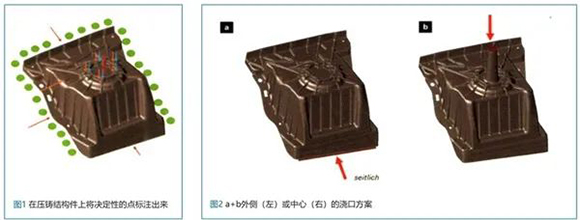
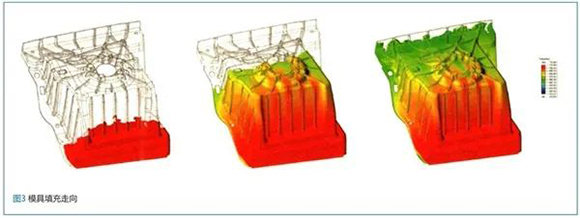
After figuring these out, we'll look at the gate concept in a second example (from the outside (Fig. 2, left) and center (Fig. 2, right)). Both require different tool concepts, each of which incurs a different cost, so they can be compared. Both concepts can be found in industry and both have many advantages and disadvantages of their own, depending on requirements, quantities, etc.
For the simulation process, the CAD dataset will be imported into the simulation system Inspire Cast. For this purpose, the Catia, NX, ProEngineer, Inventory and Solid Works native translators as well as the system-neutral STEP and Parasolid translators are used as interfaces. The system is compatible with Parasolid-Kernel, which is now widely used in industry. In the Inspire Cast system, gate locations can be precisely set with just a few clicks after the casting has been CAD imported. These features are designed in such a way that the relevant geometric elements can be easily projected and aligned with defined cross-sectional areas in just a few minutes. Therefore, there is no need for costly CAD design of the gate system in an external CAD system.
Since 3D data often goes through several interfaces before entering the computing department, an internal adjustment mechanism ensures that erroneous area data or non-internal volume data is corrected if necessary. The cost of model preparation and nightly calculations is negligible. Pure CAD data in the specified format from the customer or development department is a prerequisite for smooth import and fast calculation. Networking in the lnspireCast system according to the FEM method means that the contour of the casting can be reproduced very precisely. In addition, the FEM mesh is automatically refined in thinner walls (eg, within sections), allowing for improved accuracy.
Ratio of time spent in the simulation process of the two gate systems (unstructured):
CAD export/import step/prasolid: 10 minutes
Parameter setting: 20 minutes
Fill calculation/medium load: 4 hours
Solidification calculation / medium load: 1 hour
Total time (per simulation process): ~5.5 hours
Outcome evaluation: 4 hours
Total time required to draw conclusions: 9 hours
Mold Fill Results Section 1, Side
Typical die casting process turbulence can be seen in the gate area at the beginning of mold filling. Air collects on the sides of the section, so this location must be vented later. Compared to the gate system at the other end of the module, a large area of venting is required afterwards (Figure 3). As can be seen from the further process, much of the planned side exhaust port design can be omitted.
Solidification Results Section 1, Side
Solidification calculations reveal the porosity in the helical dome, which must be treated with a core or, if necessary, with an extrusion pin. Since the section has been solidified previously, optimization cannot be done in stage 3 (Fig. 4).
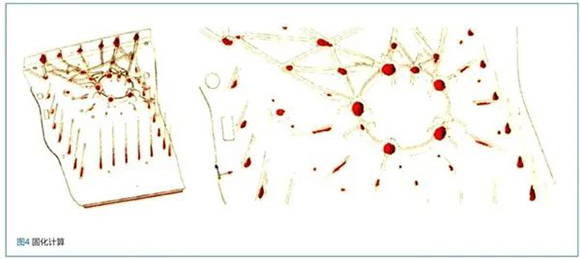
Mold Filling/Solidification Results Section 2, Center
The results are shown in Figure 5. The mold filling through the center gate is uniform. As can be seen from the figure, several vent locations need to be designed around the assembly (Figure 6). The solidification is almost identical to the side gating system. The rapid solidification of the section prevents us from exerting any influence on the porosity of the center gating system.
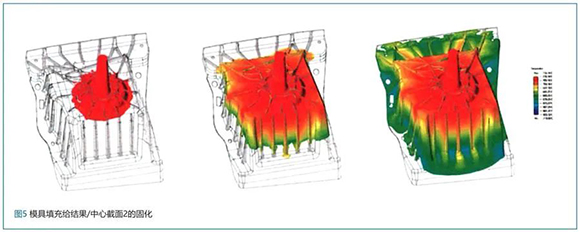
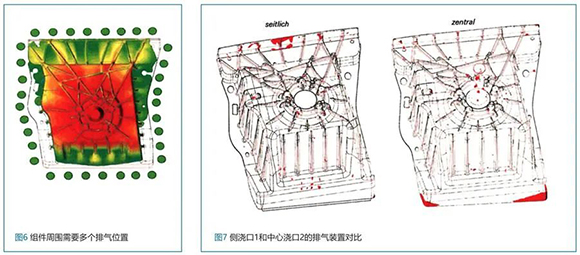
Comparison of ventilation between side gate 1 and center gate 2
A comparison of air inclusions caused by turbulence shows that the expected concentration occurs in the side gating system compared to the cross section. The vacuum system should then be installed there (Figure 7).
Results comparison

Table 1 lists the comparison for the two sections. In this case, according to the current development trend, the side gating system is the better choice. As mentioned above, both options can be found in practice, where designs vary depending on component geometry or cost factors such as volume or machine productivity.
Production Preparation
During the development phase, the simulation process may be terminated due to a final decision. The next step after the customer places an order is production preparation. To do this, first check the flow characteristics of the side gating system. In this case, we will use a simple shell and compare different cross-sectional geometries (Figure 8). Considered here are two tangential sections with different inlet angles and two sector sections with different inlet cross sections. The tangential section doesn't seem to work at all for our shell. Immediately behind the inlet creates an area of negative pressure from the piston, with turbulence and increased air entering the assembly. Turbulent flow can still be seen in the range of the side enlargement (Option 3) even in the sector of the single-sided inlet (for example, on the ejector side of the die). The best deformed structure uses a circular inlet at the end of the fan gate, where turbulence is no longer seen during the simulation (Scenario 4) (Figure 9). The simulations demonstrate the advantage of the sector section, ie the air entry into the die casting is significantly reduced.
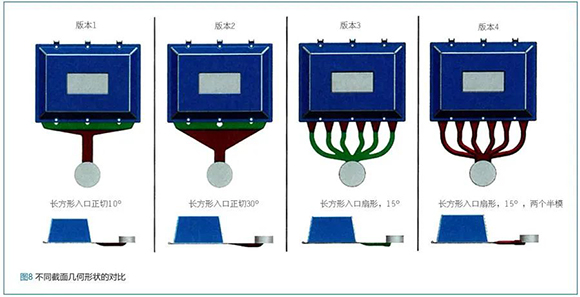

Air inclusions caused by turbulence are certainly not the only measure of successful mold filling. However, in a relatively inexpensive simulation process, each criterion can be studied more precisely and optimized to gradually reduce sources of error. Today, our production models will add realistic gating systems and functional exhaust systems (Figure 10). In addition, factors such as mold or part geometry and heat/cooling circuits should also be taken into account when simulating under production conditions. We adjust the model accordingly and define it in the Inspire Cast system.
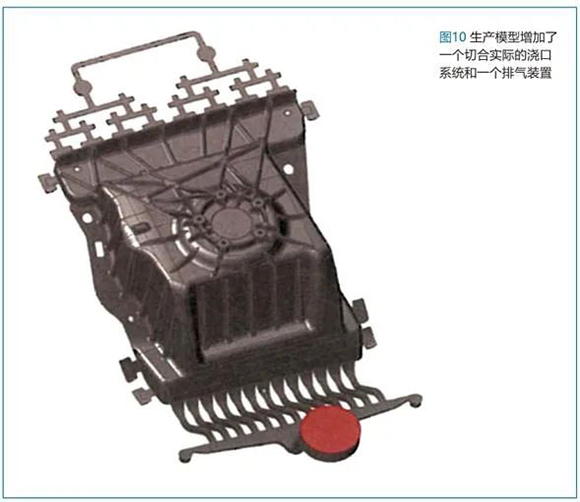
Mold Filling Results Production Model
Our first consideration is the mold filling (Fig. 11) as the result of the calculation. Die filling is performed in a laterally specified manner with several sector sections. As expected, the air present in the system will collect in the exhaust area (Figure 12).
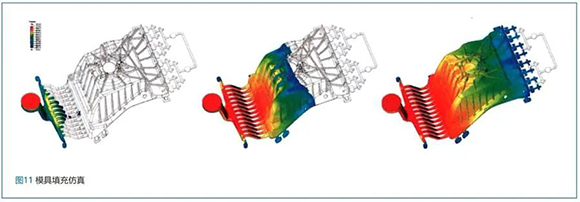
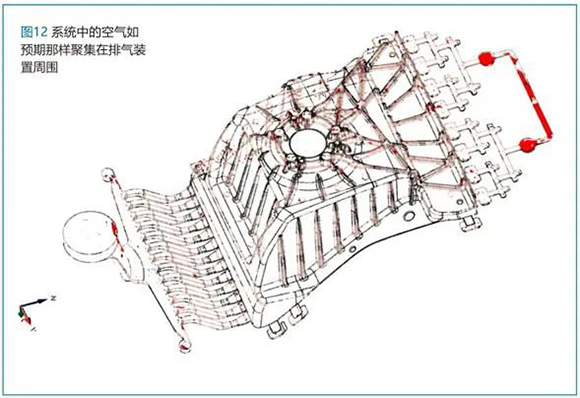
Solidification of production models
Unfavorable porosity in the mounting hole area is a unavoidable situation, as confirmed during development and during the preceding simulations. The cross-section system had solidified after 1.0 seconds, so no further filling of the critical area was possible (Figure 13). Therefore, within the dome, only the core or the extruder may be able to achieve the desired effect.
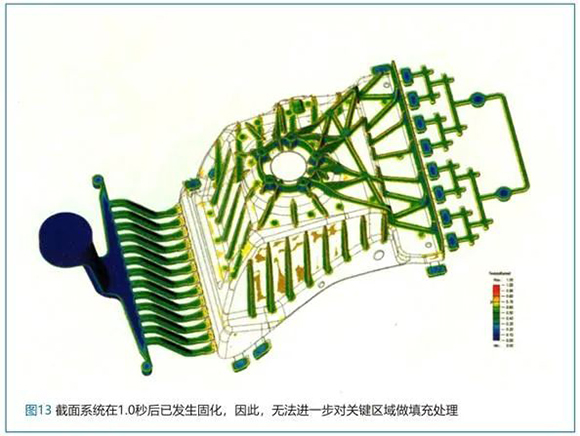
Influence of cooling device during simulation
The entire cooling plant was simulated during the simulation. The effect of cooling devices should be studied on a regional basis. If the porosity is to be influenced by targeted cooling, the cooling in the area of the mounting holes should be changed and calculated. The temperature was calculated 5 seconds after the end of mold filling. When calculating the temperature, the distance between one time and the contour is 25mm, and the distance between one time is 10mm. The calculated temperature difference is only 2°C. Other effects such as spray or cycle time are excluded first. From this, it can be seen that the effect caused by the rapid solidification of the die casting side shell is expected to be small here. For this, consider using squeeze pins.
In Conclusion
Convincing simulation results for mold filling and solidification can be calculated at a fraction of the cost early in the casting development process. Results are available in a few hours with negligible expense for data entry and computational effort. CAD data is a prerequisite for this work. The formulation of quotations or estimates in relation to anticipated production activities can be decisively supported and reflected more precisely. For some time now, Inspire Cast has provided an easy-to-use and very convincing tool.
For production, more in-depth simulations are required, typical casting techniques need to be adjusted (such as casting runners, cross-section and overflow design, etc.), and thermal conditions in the tool are optimized to ensure that the simulation process does not Any problems occur and are further optimized. Pre-defined functions are already available in the Inspire Cast system. Feedback from industrial companies shows a high degree of agreement between simulation results and real components. On this basis, the thermomechanical coupling of Inspire Cast will be launched soon, so more practical situations will be taken into account.

地址:浙江省宁波市北仑区大碶沿塘河路6号
孙跃君:13806631860
王式雍:15958891460 / 15058297768
电话:0574-86140828 / 0574-86140818
传真:0574-86140828